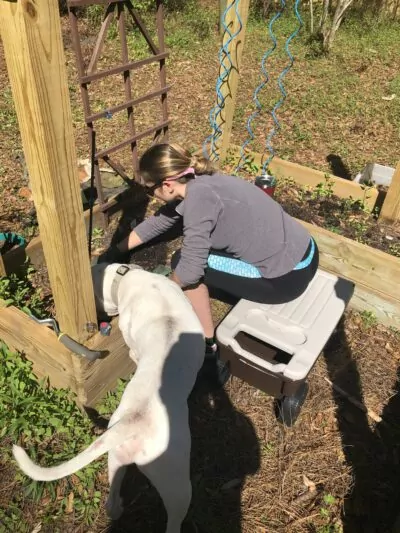
For me, gardening is the perfect balance of gentle exercise, time well spent outdoors, and the unexpected feeling of joy and pride brought upon by tending and caring for something that produces a tangible benefit, such as beautiful flowers or delicious vegetables.
In this post, I’d like to share the benefits I’ve received from my gardening hobby and some tips I’ve discovered in my search for ways to make gardening vestibular-friendly.
Why Gardening?
One of the many challenges of having a vestibular disorder is getting enough exercise, especially outdoors where there is little to no control over triggering factors. High heat and humidity, allergens, and uneven ground can pose a risk for many, on good days and bad.
Though I have always had an interest in plants, my diagnosis of vestibular migraine in the summer of 2020 was what truly drew me to the hobby of gardening. An avid hiker, the sudden chronic dizziness associated with vestibular migraine took my ability to exercise and spend time outdoors from me in the blink of a room-spinning eye. Though I could no longer hike the lengths and uneven grounds I was used to, I decided to try to find a way to get some light exercise while still spending time outdoors. Enter: vegetable gardening. What started as a way to cope with the loss of more active movement has become a beloved hobby, fueled by my love for nature, cooking, and, of course, eating!
Types of Gardens
Growing a garden can be done anywhere, whether it be in containers or garden beds, in any weather, and with as much or as little effort as you wish to provide. The key is to select the right plants for the amount of effort you are willing to provide, as growing a garden is more than just planting a few seeds–-you need to tend and care for your plants, providing them with the right amount of water, sunlight, and heat for them to prosper.
If you’d like to start your own garden, the first step is to look up what zone you are in. The United States Department of Agriculture created a Hardiness Zone Map, which serves as the standard by which gardeners and growers can determine which plants are most likely to thrive in a particular environment based on your location, whether they be landscaping plants, ornamental flowers, or vegetables. The map is based on the average annual minimum winter temperature, divided into 10-degree Fahrenheit zones.
Once you find your zone, you can assess your yard or property to determine what kind of space you have to dedicate to your plants. Many plants do wonderfully in containers, so even in limited space it is possible to have a thriving garden. Then it’s time to select your plants and get growing!
Gardening with a Vestibular Disorder
While gardening is light in exercise, there are still challenges that may arise for those of us with vestibular issues. However, there are many strategies and adjustments that can be made to make gardening an accessible activity. For example, if leaning over and tilting your head can be triggering, building raised garden beds, or using only containers that can be moved can provide relief. Utilizing tools such as a garden bench, hose handle extender, and outdoor-safe shelving can allow you to remain upright while still tending to your garden. If heat and sunlight contribute to your threshold, as they do for me, a big sun-blocking hat and dark sunglasses can do wonders in protecting you from the sun, while taking frequent water breaks may provide some relief from the heat. Also, choose a cool time of day, such as early morning, to do your gardening, and avoid extended periods of time in direct sunlight.
Gardening is a skill that often takes time, and a good amount of trial and error, to get good results, so don’t be discouraged if you aren’t replacing the grocery store or have a thriving flower garden just yet. The real joy of gardening is the time spent doing it!
